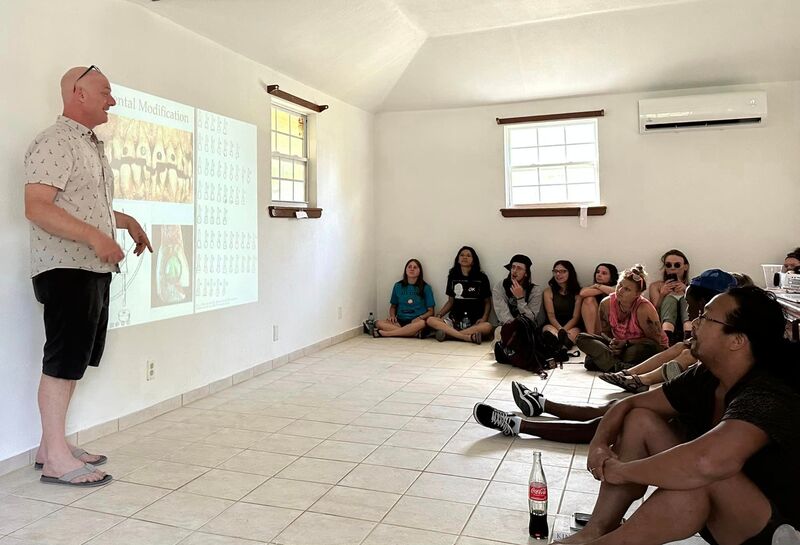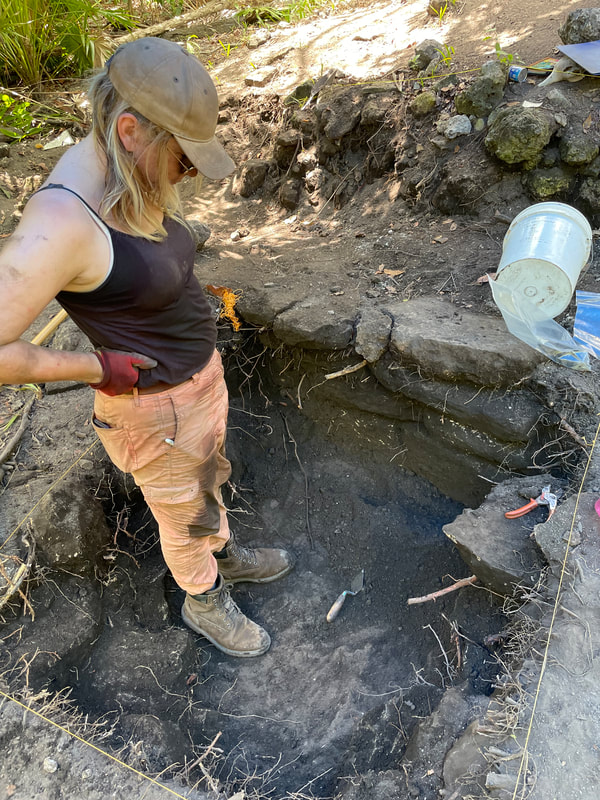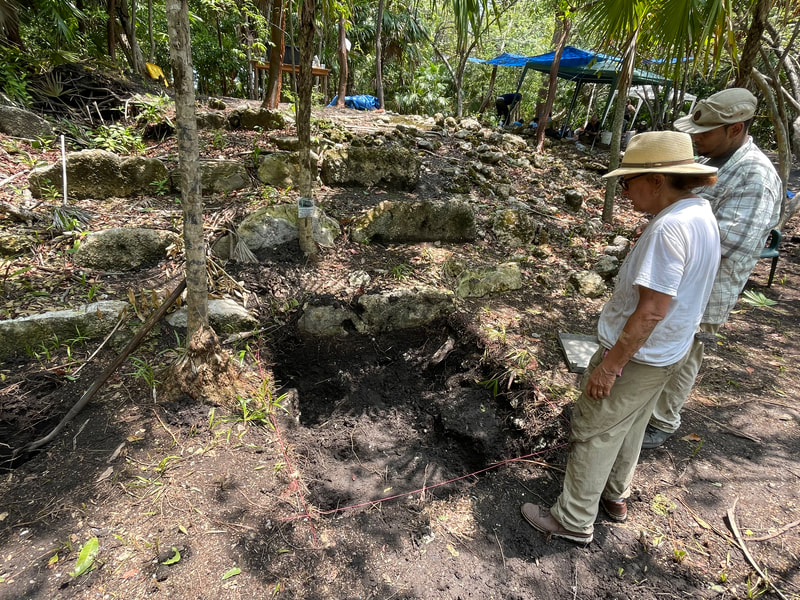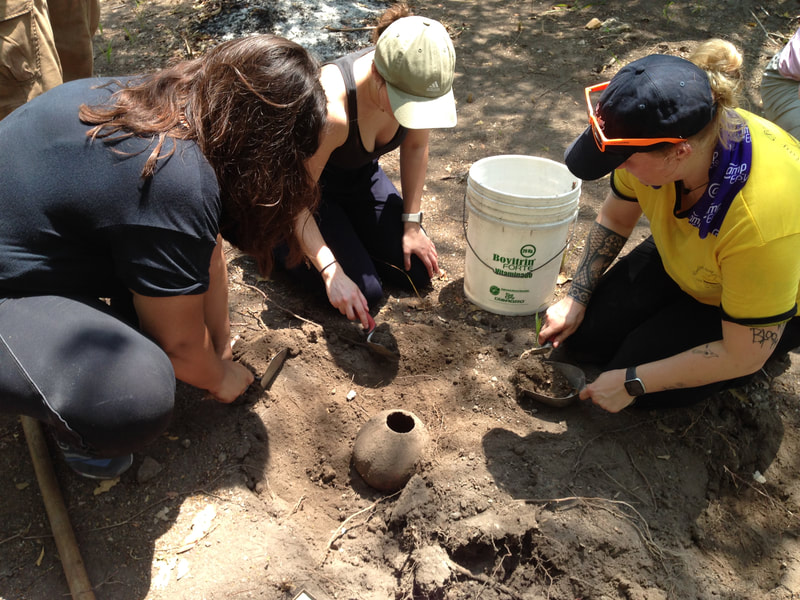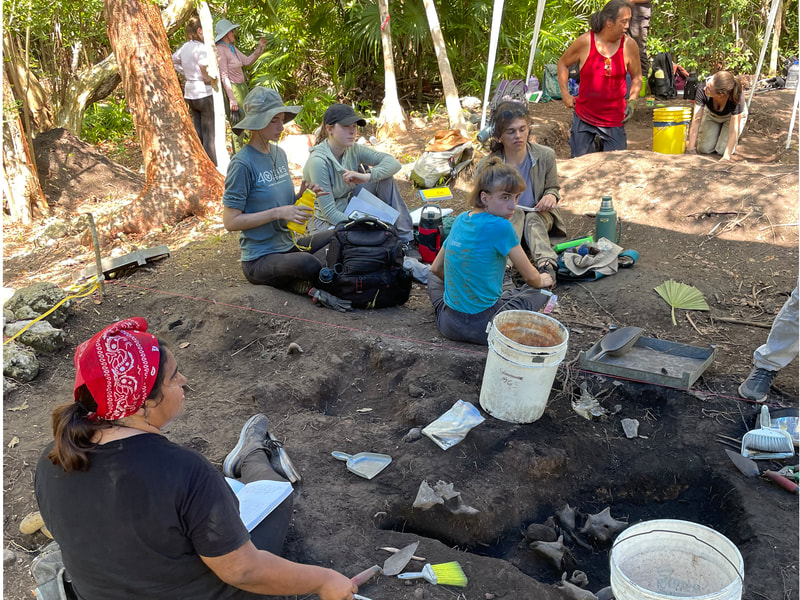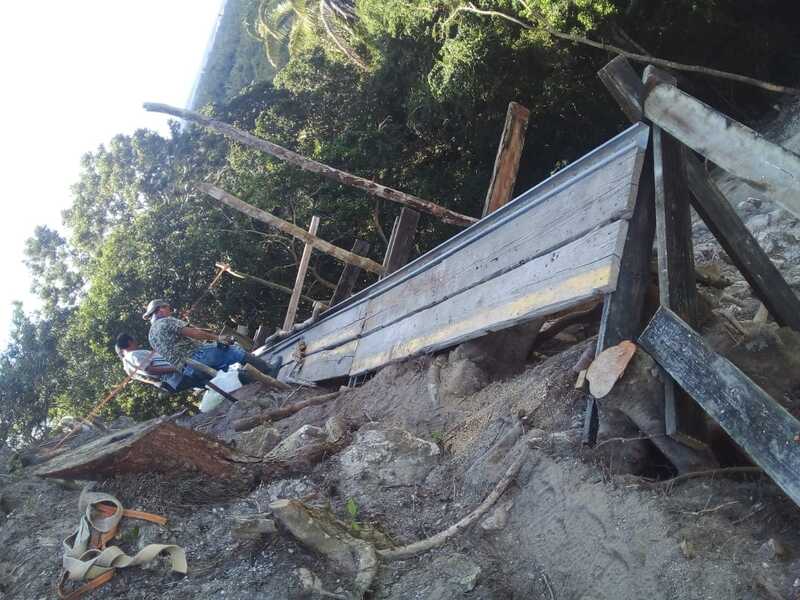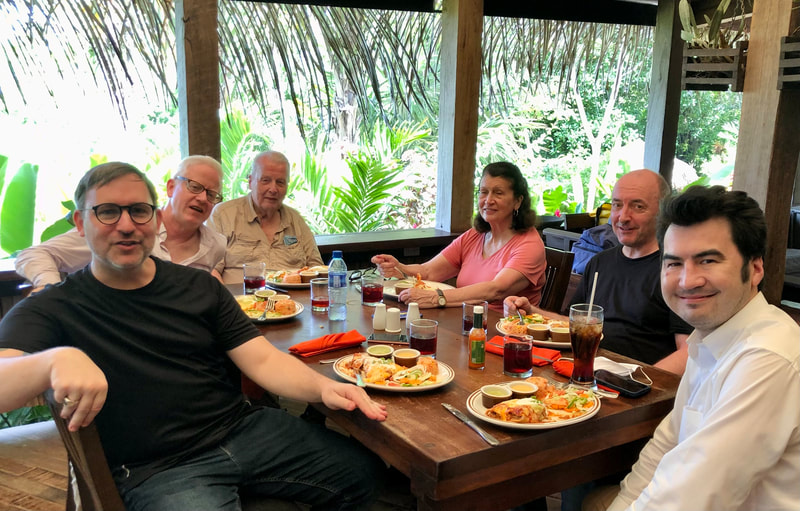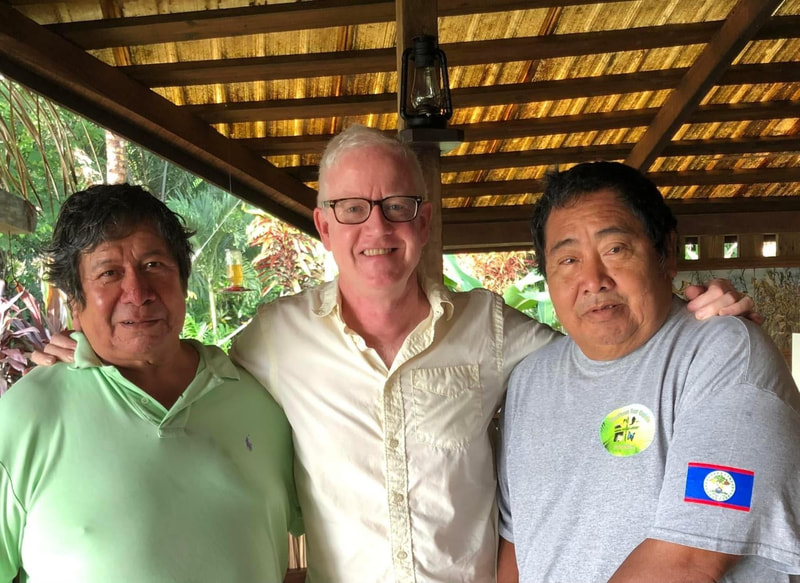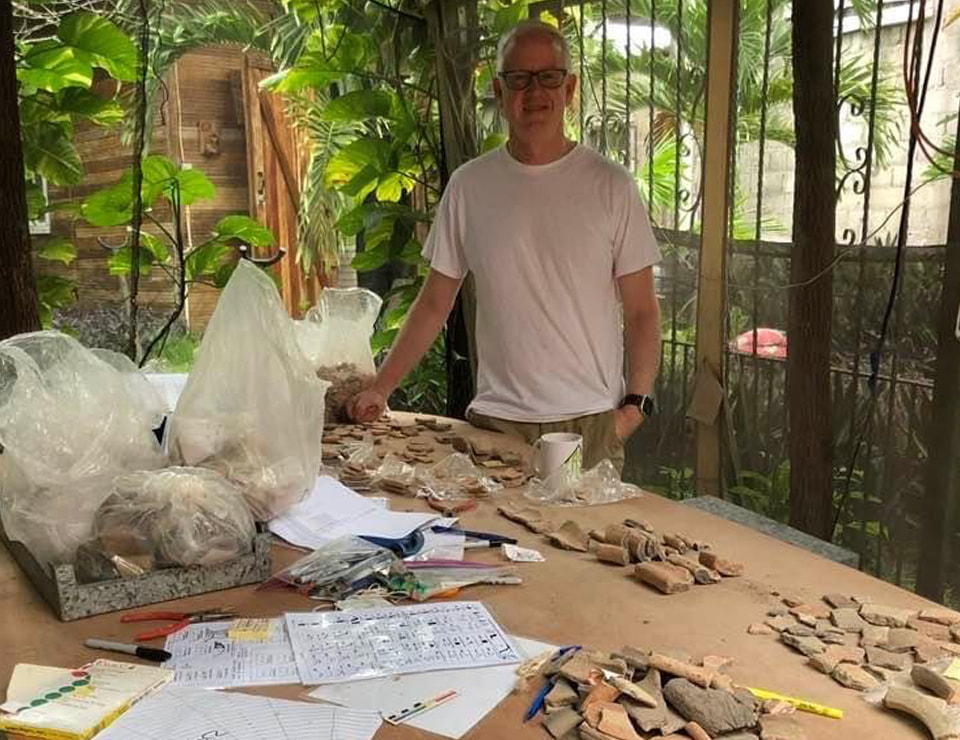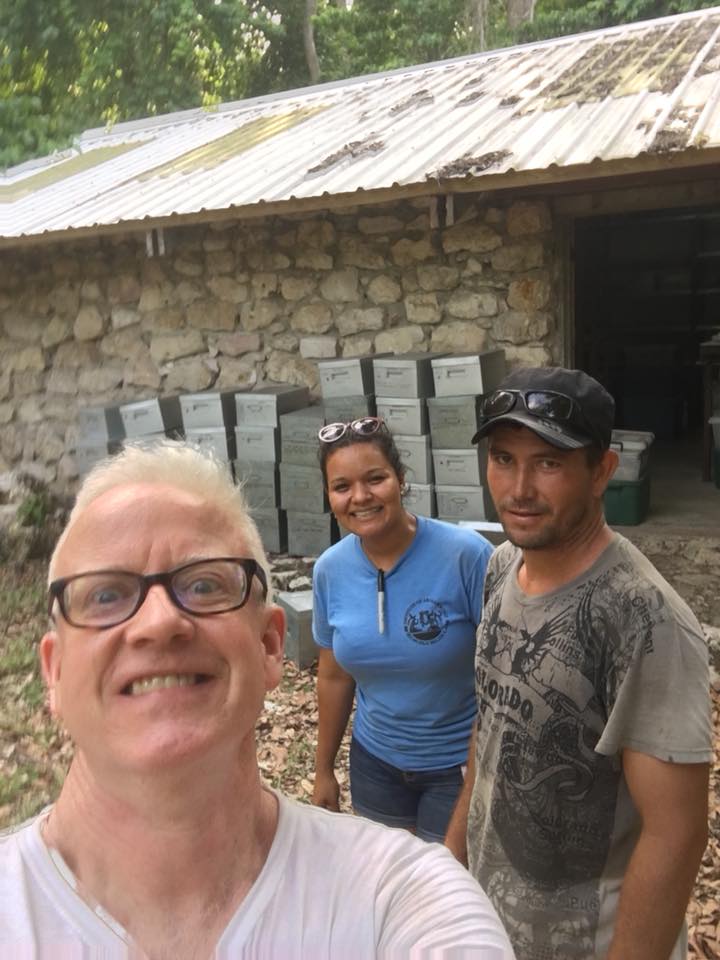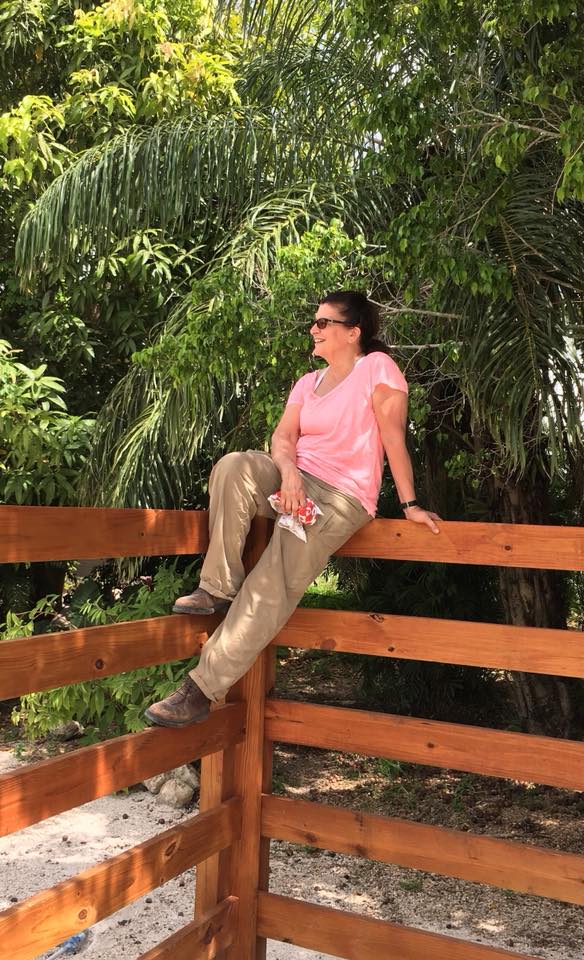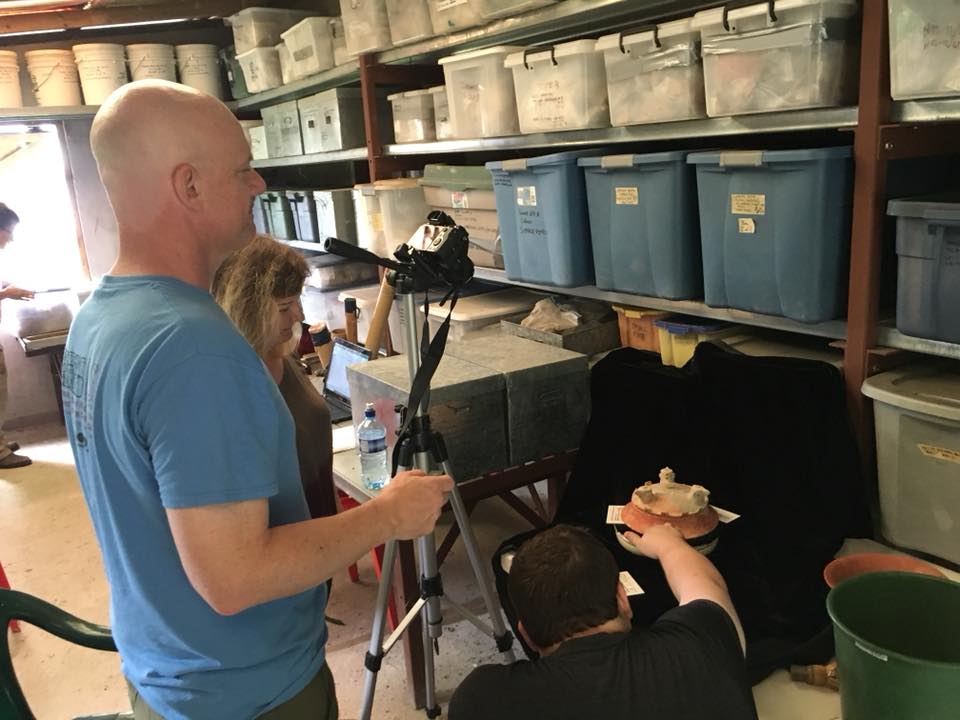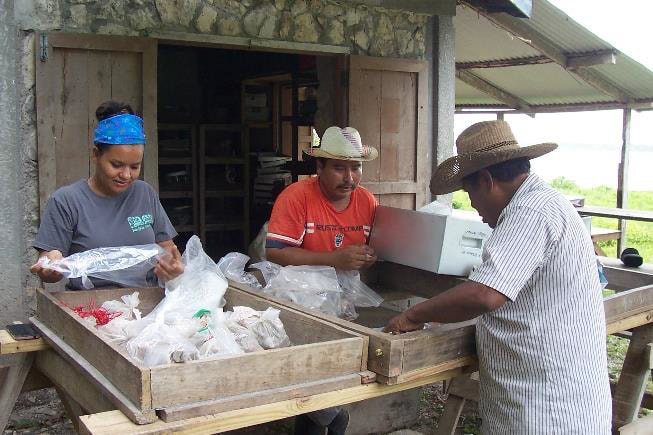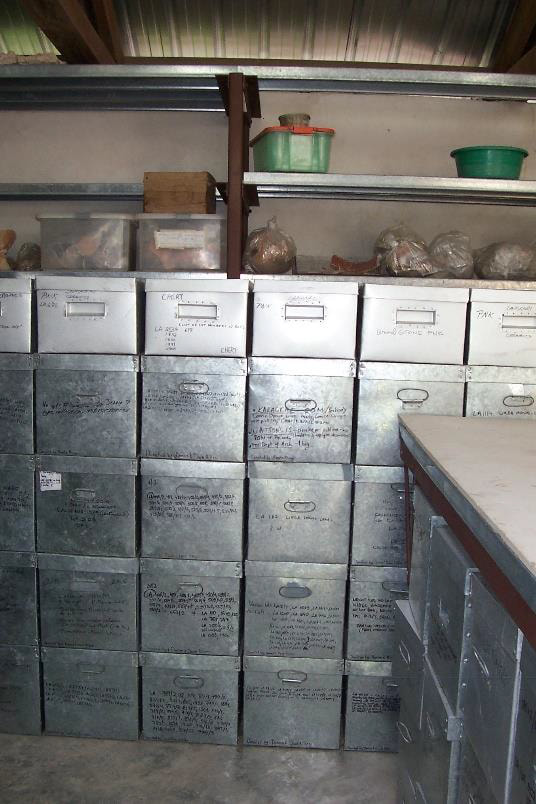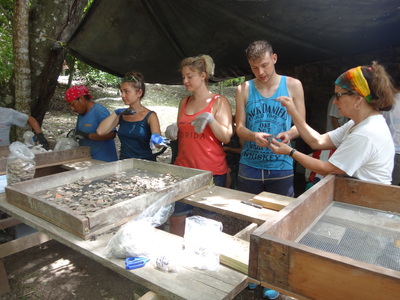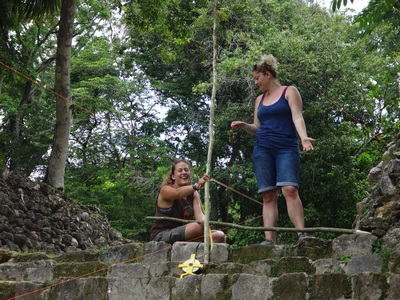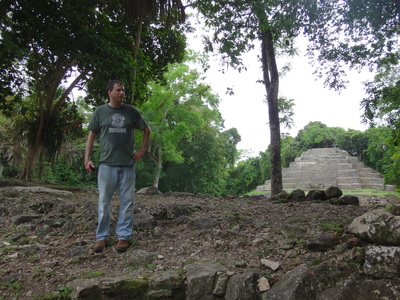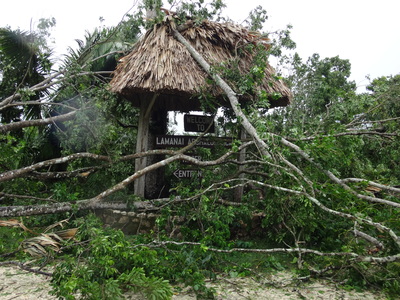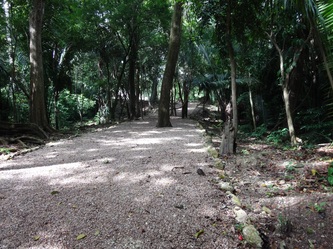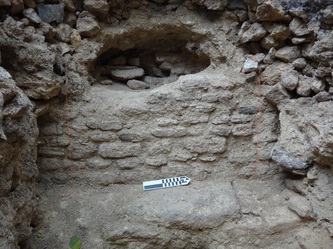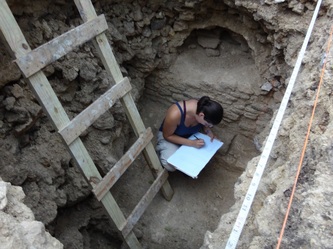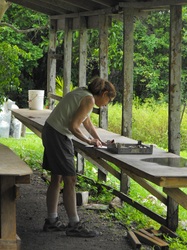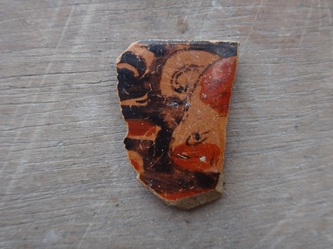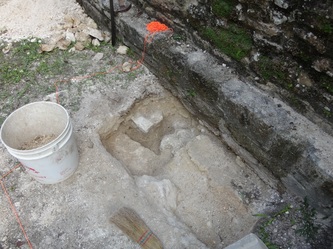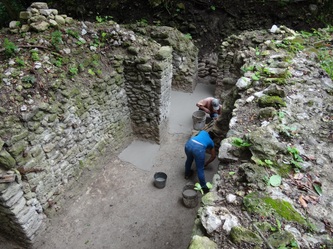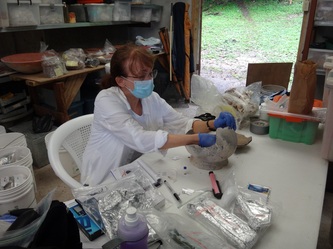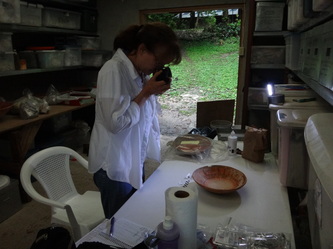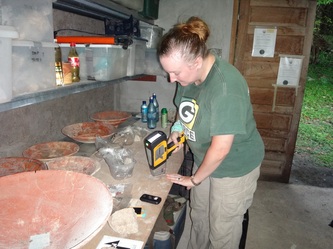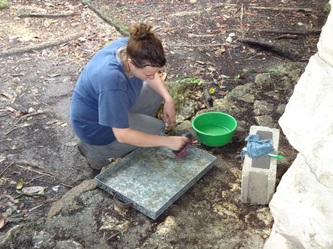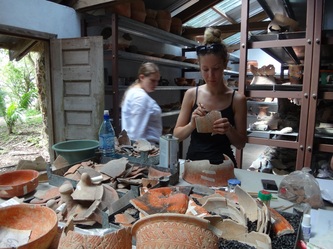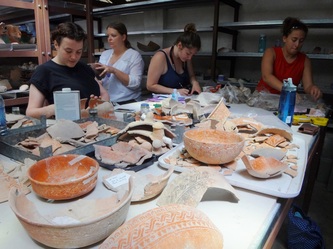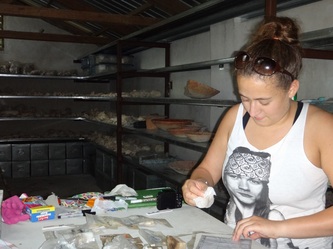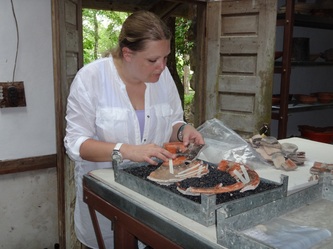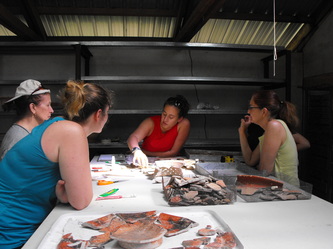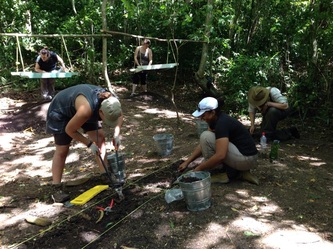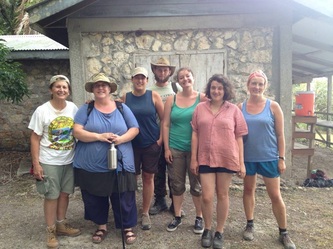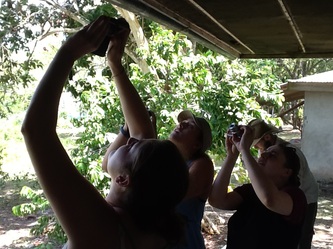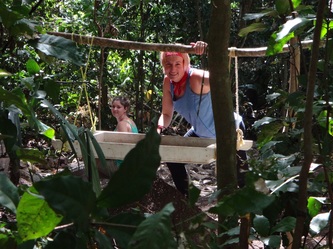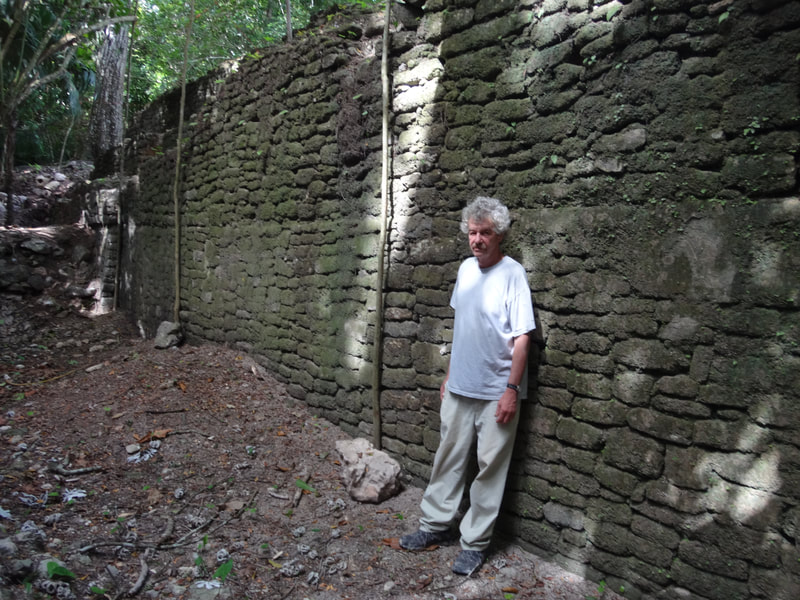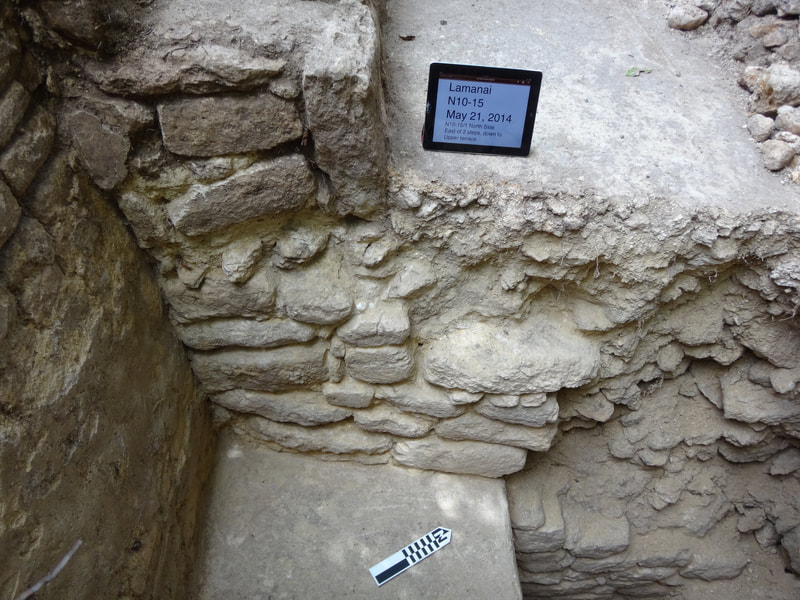MARCO GONZALEZ & LAMANAI 2023 Field Season: June
The primary focus of the Marco Gonzalez site 2023 field school excavations led by Dr. Liz Graham (University College London) and Dr. Gabe Wrobel (Michigan State University) was to continue investigations at Structure 14, a residential structure in which a number of burials were found during excavations in previous years. The small mangrove-encircled, mosquito-infested, Maya site of Marco Gonzalez, on Ambergris Caye, has six plaza groups with a total of 49 structures, which are all fairly low platforms ranging in height from 30 cm to 4.2 meters. Investigations by Drs. Liz Graham, David Pendergast, and Scott Simmons have "revealed that the site had been both a busy and prosperous trading port in the Terminal Classic and Early Postclassic periods. Pre-Terminal Classic deposits...led Graham to consider that the site was also a locus of salt production" (Simmons & Graham 2016, Coastal Adaptations). "Ceramics from the graves date from the end of the Late Classic period through Terminal Classic times. Polychromes, generally simple in design, are present but give way to monochrome wares such as Fine Orange, plumbate, Augustine Red, and possibly Teabo Red...A number of burials included goods obtained from distant locations as well as finely crafted objects from local sources." During our recent field school Dr. Liz Graham gave a lecture to the students to introduce them to the site and some of the ceramics that have been found there in previous excavations. We found some interesting pottery this season too!
Research was also conducted at Lamanai by one of Liz Graham's PhD students, and Dr. Jim Aimers had a quick 3-day session of pottery analysis. Throughout the year the Institute of Archaeology carried out a project, directed by Jorge Can, to stabilize Structure N10-43, the High Temple, and to consolidate structures that share the same plaza, Plaza N10[5].
The primary focus of the Marco Gonzalez site 2023 field school excavations led by Dr. Liz Graham (University College London) and Dr. Gabe Wrobel (Michigan State University) was to continue investigations at Structure 14, a residential structure in which a number of burials were found during excavations in previous years. The small mangrove-encircled, mosquito-infested, Maya site of Marco Gonzalez, on Ambergris Caye, has six plaza groups with a total of 49 structures, which are all fairly low platforms ranging in height from 30 cm to 4.2 meters. Investigations by Drs. Liz Graham, David Pendergast, and Scott Simmons have "revealed that the site had been both a busy and prosperous trading port in the Terminal Classic and Early Postclassic periods. Pre-Terminal Classic deposits...led Graham to consider that the site was also a locus of salt production" (Simmons & Graham 2016, Coastal Adaptations). "Ceramics from the graves date from the end of the Late Classic period through Terminal Classic times. Polychromes, generally simple in design, are present but give way to monochrome wares such as Fine Orange, plumbate, Augustine Red, and possibly Teabo Red...A number of burials included goods obtained from distant locations as well as finely crafted objects from local sources." During our recent field school Dr. Liz Graham gave a lecture to the students to introduce them to the site and some of the ceramics that have been found there in previous excavations. We found some interesting pottery this season too!
Research was also conducted at Lamanai by one of Liz Graham's PhD students, and Dr. Jim Aimers had a quick 3-day session of pottery analysis. Throughout the year the Institute of Archaeology carried out a project, directed by Jorge Can, to stabilize Structure N10-43, the High Temple, and to consolidate structures that share the same plaza, Plaza N10[5].
LAMANAI 2022 Field Season: June/July
Drs. David Pendergast and Elizabeth Graham led another short field season. David returned to Lamanai to undertake research for an inscriptions project funded by National Geographic. Dr. Michael Pittman, a paleobiologist, studied the monuments using LSF imaging (laser-stimulated fluorescence). Liz worked with her UCL students on their research. in June and returned again for more analysis in the fall. Other archaeologists did other research.
Drs. David Pendergast and Elizabeth Graham led another short field season. David returned to Lamanai to undertake research for an inscriptions project funded by National Geographic. Dr. Michael Pittman, a paleobiologist, studied the monuments using LSF imaging (laser-stimulated fluorescence). Liz worked with her UCL students on their research. in June and returned again for more analysis in the fall. Other archaeologists did other research.
LAMANAI 2018 Field Season: July
Drs. David Pendergast and Elizabeth Graham led a very short field season in early July 2018, focused on some preliminary information gathering for future grant applications and other projects. Dr. Jim Aimers, Liz Graham, and Karen Pierce, inventoried the boxes of rehoused ceramic artifacts with the help of two people from the local village: Brenda Arevalo and Sondro Corado (Figures 1, 2, 3, and 4) . Dr. Gabe Wrobel and two of his students photographed some of the Lamanai ceramic artifacts as a trial for a future artifact photogrammetry documentation project (Figure 5). Drs. David Pendergast, Sherman Horn, and Brian did other exploratory research (Figure 6).
Drs. David Pendergast and Elizabeth Graham led a very short field season in early July 2018, focused on some preliminary information gathering for future grant applications and other projects. Dr. Jim Aimers, Liz Graham, and Karen Pierce, inventoried the boxes of rehoused ceramic artifacts with the help of two people from the local village: Brenda Arevalo and Sondro Corado (Figures 1, 2, 3, and 4) . Dr. Gabe Wrobel and two of his students photographed some of the Lamanai ceramic artifacts as a trial for a future artifact photogrammetry documentation project (Figure 5). Drs. David Pendergast, Sherman Horn, and Brian did other exploratory research (Figure 6).
LAMANAI 2017 Field Season: May & June
The four-week 2017 Field Season at Lamanai began on May 9th, directed by Drs. David Pendergast and Elizabeth Graham. Two workmen from the local village were hired to assist: Don Antonio Esquivel and Adolfo Sanchez (Figure 1), with occasional assistance from Outpost staff member, Brenda Arevalo (Figure 2) .Work in 2017 was concentrated on completion of the initial stage of sorting and re-housing in metal boxes (Figures 3 and 4) of all material resulting from the excavations carried out at the site, as well as all material recovered during the work of restoring ancient structures and the construction of tourist facilities.
On July 8th and 9th, Christophe Helmke, the epigrapher for the Lamanai Archaeological Project (1998–present), and Jorge Can (Archaeological Conservator, Belize Institute of Archaeology) documented the carved monuments found at Lamanai as part of excavations conducted at the site under the direction of Dr. David M. Pendergast (1974–1988) (see Pendergast 1975, 1977, 1981a, 1981b, 1984, 1986a, 1986b). See the 2017 Field Season report for more details.
The four-week 2017 Field Season at Lamanai began on May 9th, directed by Drs. David Pendergast and Elizabeth Graham. Two workmen from the local village were hired to assist: Don Antonio Esquivel and Adolfo Sanchez (Figure 1), with occasional assistance from Outpost staff member, Brenda Arevalo (Figure 2) .Work in 2017 was concentrated on completion of the initial stage of sorting and re-housing in metal boxes (Figures 3 and 4) of all material resulting from the excavations carried out at the site, as well as all material recovered during the work of restoring ancient structures and the construction of tourist facilities.
On July 8th and 9th, Christophe Helmke, the epigrapher for the Lamanai Archaeological Project (1998–present), and Jorge Can (Archaeological Conservator, Belize Institute of Archaeology) documented the carved monuments found at Lamanai as part of excavations conducted at the site under the direction of Dr. David M. Pendergast (1974–1988) (see Pendergast 1975, 1977, 1981a, 1981b, 1984, 1986a, 1986b). See the 2017 Field Season report for more details.
LAMANAI 2016 Field Season: July through August
In the 2016 field season archaeologist Dr. David Pendergast, who excavated at Lamanai from 1974-1986, joined Dr. Elizabeth Graham, the Lamanai PI (Principal Investigator), and UCL Institute of Archaeology students to work on the rehousing of Lamanai artifacts into new metal storage boxes. Although we still do not have enough of these boxes (see the support Lamanai page for more info on this and how you can help), the pottery sherds and other materials that had been stored in sugar sacks were sorted and placed either new boxes or temporarily in new sugar sacks. Artifacts were sorted by materials to make future research on particular materials, such as obsidian, chert, stone, shell, bone, metals, and historic materials, more easily accessible to researchers. This work will continue next field season. Additionally mapping of the Ottawa Group's N10-77 building and terraces was conducted by Karen Pierce, Gabi Dziki, Ella Békési, and Mark Shelby. Arianne Boileau, who is working on her PhD at the University of Florida, continued to analyzed turtle bones as part of her study concerning social status and community organization at the moment of Maya Spanish contact as revealed by zooarchaeology at Lamanai, Belize.
As we finished our field season Lamanai, the adjacent village of Indian Church, and much of Belize was struck by Hurricane Earl on August 3rd/4th, resulting in many trees and branches coming down at Lamanai, but with little to no damage to the ancient structures and modern buildings at the site, and no injuries locally. Local tour guides volunteered to help the park rangers clean up the site, which was reopened on August 8th.
In the 2016 field season archaeologist Dr. David Pendergast, who excavated at Lamanai from 1974-1986, joined Dr. Elizabeth Graham, the Lamanai PI (Principal Investigator), and UCL Institute of Archaeology students to work on the rehousing of Lamanai artifacts into new metal storage boxes. Although we still do not have enough of these boxes (see the support Lamanai page for more info on this and how you can help), the pottery sherds and other materials that had been stored in sugar sacks were sorted and placed either new boxes or temporarily in new sugar sacks. Artifacts were sorted by materials to make future research on particular materials, such as obsidian, chert, stone, shell, bone, metals, and historic materials, more easily accessible to researchers. This work will continue next field season. Additionally mapping of the Ottawa Group's N10-77 building and terraces was conducted by Karen Pierce, Gabi Dziki, Ella Békési, and Mark Shelby. Arianne Boileau, who is working on her PhD at the University of Florida, continued to analyzed turtle bones as part of her study concerning social status and community organization at the moment of Maya Spanish contact as revealed by zooarchaeology at Lamanai, Belize.
As we finished our field season Lamanai, the adjacent village of Indian Church, and much of Belize was struck by Hurricane Earl on August 3rd/4th, resulting in many trees and branches coming down at Lamanai, but with little to no damage to the ancient structures and modern buildings at the site, and no injuries locally. Local tour guides volunteered to help the park rangers clean up the site, which was reopened on August 8th.
LAMANAI 2015 Field Season: May through July
In the 2015 field season new metal shelves were built by Claude Belanger in the "Old" Lamanai museum. Under the direction of Dr. Elizabeth Graham, the Lamanai PI (Principle Investigator), UCL Institute of Archaeology students Gabi Dziki, Ella Békési, Cat Gregori, Lily Kidulis and UCL graduate Synnove Kvam Stromsvc, cleaned and rehoused small finds, cleaned pottery and did some vessel reconstruction. These activities took place in the "old" site museum, as you'll see in the photos below. We were grateful to have volunteer Mark Wheeler with us again from England, who helped in numerous ways, including sherd washing, screening, and photography.
Arriving at the Ottawa N10[3] Group this year we found a new pathway had been constructed by the Institute of Archaeology, which brings tourists from the Stela Temple--which is located north of Ottawa--to the north side of Structure N10-15 when one arrives at the Ottawa Group from this direction. This new path lies over an area which we observed in 2014 as a possible sacbe, so visitors may now experience an ancient approach to Ottawa. Claude Belanger did some mapping and reconciled the levels for the Ottawa Group and also supervised the clearing of vegetation in and around Structure N10-17 in the Ottawa group, and oversaw the subsequent plastering of the floors in N10-17, which was requested by Dr. John Morris of the Belize Institute of Archaeology. Claude Belanger and Karen Pierce (MA student at University of Colorado/Denver) put in a 1x4 meter test unit in the plaza floor on the south, or courtyard side, of N10-15 to determine if the buried N10-28 (Tulip) terrace we encountered in 2014 extended south across the courtyard. It did not, but we found the wall of another earlier building under the plaza floor. Liz Graham also put in a small test unit in the plaza floor on the north side of Structure N10-77 to determine if the basal molding of that structure may have once been a terrace that extended down below the plaza floor, but it didn't.
Several PhD students from different universities came to Lamanai to do some laboratory analysis on previously excavated material. Lisa Duffy, University of Florida, took samples from pottery vessels for purposes of identifying the residues on ancient food production tools to determine what substances they may have held, which ultimately helps archaeologists learn about vessel and tool function, foodways, subsistence, economy and ritual activities. Arianne Boileau, University of Florida, analyzed turtle bones as part of her study concerning social status and community organization at the moment of Maya Spanish contact as revealed by zooarchaeology at Lamanai, Belize. Tawny Tibbits, The University of Iowa, did portable x-ray fluorescence to nondestructively source granite archaeological artifacts such as manos and mutates as part of her larger geochemical sourcing project in the Maya Lowlands of Belize. She also did XRF on a few other things the Lamanai archaeologists were curious about!
As a follow-up to the archaeological research conducted in 2014 at Lamanai, we are posting the field season reports on the Publications page of this website (in progress), and a 14.5 minute digital-video (Pierce, Belanger and Graham 2015) summarizes the 2014 excavations at Structure N10-15 in Ottawa--https://youtu.be/SkikGgxKevU.
In the 2015 field season new metal shelves were built by Claude Belanger in the "Old" Lamanai museum. Under the direction of Dr. Elizabeth Graham, the Lamanai PI (Principle Investigator), UCL Institute of Archaeology students Gabi Dziki, Ella Békési, Cat Gregori, Lily Kidulis and UCL graduate Synnove Kvam Stromsvc, cleaned and rehoused small finds, cleaned pottery and did some vessel reconstruction. These activities took place in the "old" site museum, as you'll see in the photos below. We were grateful to have volunteer Mark Wheeler with us again from England, who helped in numerous ways, including sherd washing, screening, and photography.
Arriving at the Ottawa N10[3] Group this year we found a new pathway had been constructed by the Institute of Archaeology, which brings tourists from the Stela Temple--which is located north of Ottawa--to the north side of Structure N10-15 when one arrives at the Ottawa Group from this direction. This new path lies over an area which we observed in 2014 as a possible sacbe, so visitors may now experience an ancient approach to Ottawa. Claude Belanger did some mapping and reconciled the levels for the Ottawa Group and also supervised the clearing of vegetation in and around Structure N10-17 in the Ottawa group, and oversaw the subsequent plastering of the floors in N10-17, which was requested by Dr. John Morris of the Belize Institute of Archaeology. Claude Belanger and Karen Pierce (MA student at University of Colorado/Denver) put in a 1x4 meter test unit in the plaza floor on the south, or courtyard side, of N10-15 to determine if the buried N10-28 (Tulip) terrace we encountered in 2014 extended south across the courtyard. It did not, but we found the wall of another earlier building under the plaza floor. Liz Graham also put in a small test unit in the plaza floor on the north side of Structure N10-77 to determine if the basal molding of that structure may have once been a terrace that extended down below the plaza floor, but it didn't.
Several PhD students from different universities came to Lamanai to do some laboratory analysis on previously excavated material. Lisa Duffy, University of Florida, took samples from pottery vessels for purposes of identifying the residues on ancient food production tools to determine what substances they may have held, which ultimately helps archaeologists learn about vessel and tool function, foodways, subsistence, economy and ritual activities. Arianne Boileau, University of Florida, analyzed turtle bones as part of her study concerning social status and community organization at the moment of Maya Spanish contact as revealed by zooarchaeology at Lamanai, Belize. Tawny Tibbits, The University of Iowa, did portable x-ray fluorescence to nondestructively source granite archaeological artifacts such as manos and mutates as part of her larger geochemical sourcing project in the Maya Lowlands of Belize. She also did XRF on a few other things the Lamanai archaeologists were curious about!
As a follow-up to the archaeological research conducted in 2014 at Lamanai, we are posting the field season reports on the Publications page of this website (in progress), and a 14.5 minute digital-video (Pierce, Belanger and Graham 2015) summarizes the 2014 excavations at Structure N10-15 in Ottawa--https://youtu.be/SkikGgxKevU.
LAMANAI 2014 Field Season
UCL INSTITUTE OF ARCHAEOLOGY STUDENTS AT LAMANAI, 2014
University College London
UCL INSTITUTE OF ARCHAEOLOGY STUDENTS AT LAMANAI, 2014
University College London

UCL archaeology students, and friends, in the field, summer 2014.
Phil Austin, Ella Bekesi, Gabi Dziki, Cat Gregori, Daisy Harmer, Adina Mahuta, Adam Rigby with Tracie Mayfield, Sarah Wolff, Arianne Boileau and bats.
July 2014. Institute of Archaeology/University College London Professor Dr. Elizabeth Graham, the Lamanai PI (Principal Investigator), holding it all together. Boulder core at the elite residential group, Plaza Group N10[3], nicknamed "Ottawa".
Phil Austin, Ella Bekesi, Gabi Dziki, Cat Gregori, Daisy Harmer, Adina Mahuta, Adam Rigby with Tracie Mayfield, Sarah Wolff, Arianne Boileau and bats.
July 2014. Institute of Archaeology/University College London Professor Dr. Elizabeth Graham, the Lamanai PI (Principal Investigator), holding it all together. Boulder core at the elite residential group, Plaza Group N10[3], nicknamed "Ottawa".
LAMANAI 2014 Field Season
OTHER UNIVERSITY RESEARCH AT LAMANAI, 2014
OTHER UNIVERSITY RESEARCH AT LAMANAI, 2014

June/July 2014. Tracie Mayfield, University of Arizona doctoral student, UCL archaeology students, and additional team members conducted excavations to explore the British occupation at Lamanai.
In 2014, twenty-seven new archaeological trenches were opened up east of the Lamanai access road and directly north of the Spanish Churches. The excavations explored a portion of the British plantation settlement established in the early 1900s. A previously unknown building, including a brick wall, and many artfacts such as smoking pipes, bottles, imported ceramics, and the remains of animals eaten at the site were discovered during excavations. The excavation site, noted during previous survey by David Pendergast and Claude Bélanger, was chosen because nineteenth-century artifacts had been observed on the ground, which suggested that more artifacts from the late colonial period were present below the surface.
The five week project, which included both excavations and artifact analysis, was completed under the direction of Tracie Mayfield and Elizabeth Graham with the (invaluable) assistance of University College London students Ella Békési, Gaby Dziki, Cat Gregori, Daisy Harmer, Panos Kratimenos, Adina Mahuta, Alex Osborne, and Adam Rigby; professional volunteers Jennifer Hasso, Eki Isibor, Ann Samuelson, John Trotter, and Sarah Wolff; and Belize based, field technicians, Enrique Ruano and Tony Mejia.
New excavations and explorations of the nineteenth-century sugar plantation are currently scheduled for summer 2016.
In 2014, twenty-seven new archaeological trenches were opened up east of the Lamanai access road and directly north of the Spanish Churches. The excavations explored a portion of the British plantation settlement established in the early 1900s. A previously unknown building, including a brick wall, and many artfacts such as smoking pipes, bottles, imported ceramics, and the remains of animals eaten at the site were discovered during excavations. The excavation site, noted during previous survey by David Pendergast and Claude Bélanger, was chosen because nineteenth-century artifacts had been observed on the ground, which suggested that more artifacts from the late colonial period were present below the surface.
The five week project, which included both excavations and artifact analysis, was completed under the direction of Tracie Mayfield and Elizabeth Graham with the (invaluable) assistance of University College London students Ella Békési, Gaby Dziki, Cat Gregori, Daisy Harmer, Panos Kratimenos, Adina Mahuta, Alex Osborne, and Adam Rigby; professional volunteers Jennifer Hasso, Eki Isibor, Ann Samuelson, John Trotter, and Sarah Wolff; and Belize based, field technicians, Enrique Ruano and Tony Mejia.
New excavations and explorations of the nineteenth-century sugar plantation are currently scheduled for summer 2016.

May-July 2014. Karen Pierce, University of Colorado MA student, and Claude Belanger, Lamanai project architecture specialist, conducted excavations at the Ottawa elite residential structure N10-15, to gain information of the architectural sequence of that long-occupied building.

